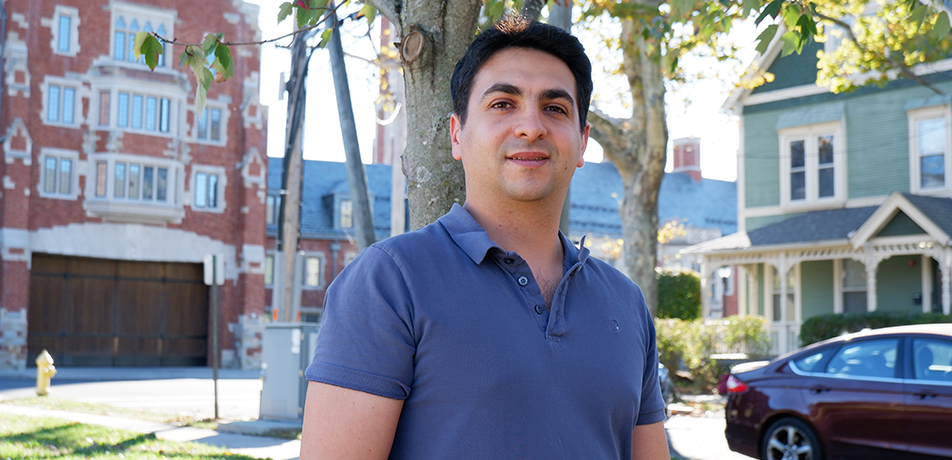From theory to (better) experiments
The applied mathematics research of Dr. Boris Landa
New scientists

Dr. Boris Landa
Life is complicated. But for researchers in the life sciences, whose experiments can generate mountains of high-resolution data, complexity is off the charts. Dr. Boris Landa—a new recruit to the Department of Computer Science and Applied Mathematics—seeks to conquer this complexity, by developing practical ways to cut through the huge data sets generated by today’s most powerful laboratory technologies, and to clear a path toward significant discoveries.
“When I was a master’s student at Tel Aviv University, one of my supervised projects was to use mathematics to solve the structure of a biological molecule,” says Dr. Landa, who made aliyah from the former Soviet Union as a child. He developed a taste for scientific research after completing an undergraduate degree in electrical engineering at the Technion-Israel Institute of Technology and serving in a research and development unit of the Israel Defense Forces.
“Using cryo-electron microscopy—a technique in which samples are examined at very low temperatures—my [TAU] advisor Prof. Yoel Shkolnisky and I gathered a large number of images. But the images were noisy; the molecule’s structure was hidden behind static, something like the chaotic patterns you see when surfing between channels on your TV screen,” he expains. “We overcame the chaos with statistics: by chipping away at the random noise, we were able to dig out the common denominator present in every one of the images. This revealed the stable, consistent structure of the molecule itself.”
Fast-tracked to a PhD in the Shkolnisky lab in the Department of Applied Mathematics, Dr. Landa continued to study mathematical principles associated with the “de-noising” of large data sets. After finishing his doctorate, he put what he’d learned to work at Yale University where, in his postdoctoral research in the Department of Mathematics, he addressed an entirely new set of challenges in biological science.
Digging into data “In my postdoc, I’ve been collaborating with Prof. Yuval Kluger in Yale’s Department of Pathology, who is an expert in the analysis of data generated by high throughput protocols like single cell RNA sequencing,” Dr. Landa says, referring to a technology that can simultaneously measure the expression of thousands of genes, in individual cells, in a biological sample that can consist of millions of cells. “The amount of data involved is staggering, and it’s very messy! In my research, I use the tools of statistics to dig into this data, clean it up, and reach scientific insights.”
While much of his work involves applying mathematical theory to clarify hard-to-interpret laboratory findings in the life sciences, Dr. Landa recently contributed to an exciting breakthrough in the world of theory itself.
In mathematics, a matrix (plural: matrices) is a table of numbers, symbols, or expressions, arranged in rows and columns, used to represent a mathematical object or a property of such an object. In some of his recent research, Dr. Landa has been focusing on “random matrices”—a construct in mathematics theory that makes it possible, when confronted with a really complicated data set, to forgo the detailed analysis of individual situations, and solve a problem based on probability. In the 1960s, it was shown that some random matrices have a very special structure, formalized in the Marchenko-Pastur law, named after the two Ukrainian mathematicians who proved it.
In the past decade, people began using the Marchenko-Pastur law to help process large data sets, like those used in genomic experiments. But there was a problem: the outcomes predicted by the law were not reflected exactly in the experimental data. There was clearly a discrepancy between theory and the real world, and Dr. Landa found a way to remedy it.
Bridging theory and real-world “We identified a procedure for transforming the data in the rows and columns of the matrix, based on numbers derived from experimental data itself,” Dr. Landa recalls. “When we applied this method, the data matched up with the law’s predicted values, and worked like a charm across dozens of datasets. It’s very exciting to advance a theory that has been around for half a century, and at the same time, contribute something that can be of practical help to life science research.”
Winding up his time in New Haven, Dr. Landa is excited about establishing his lab and continuing his research at the Weizmann Institute of Science next year. “I had a number of offers, but I think that Weizmann is the number one research center in terms of the students, and in terms of the resources available for faculty and staff,” he says.
Dr. Landa is married to a biologist whom he met while they were both serving in the IDF. Following his stint in the military, he and his wife pursued parallel professional tracks, both earning their PhDs at Tel Aviv University and undertaking postdoctoral research at Yale. They have two young children—a boy and a girl.
He adds that both he and his wife are looking forward to their children and their grandparents living in the same time zone. “The time abroad was important for both of us,” he says, “but there was no question that we wanted to live in Israel. It will be good to be back home.”
Dr. Landa played chess as a child and has continued to play tennis since he was a teenager. In his spare time—and there’s not much of that—he enjoys hiking in nature with his family
Education and select awards:
• BSc, Technion-Israel Institute of Technology (2008)
• Direct-track PhD, Tel Aviv University (2019)
• Postdoc, Gibbs Assistant Professor, Yale University (2019-2022)








